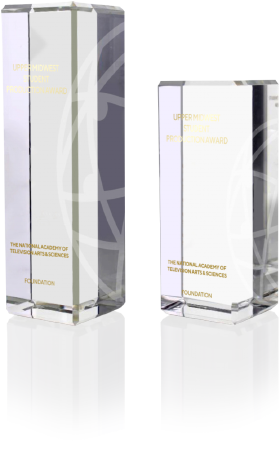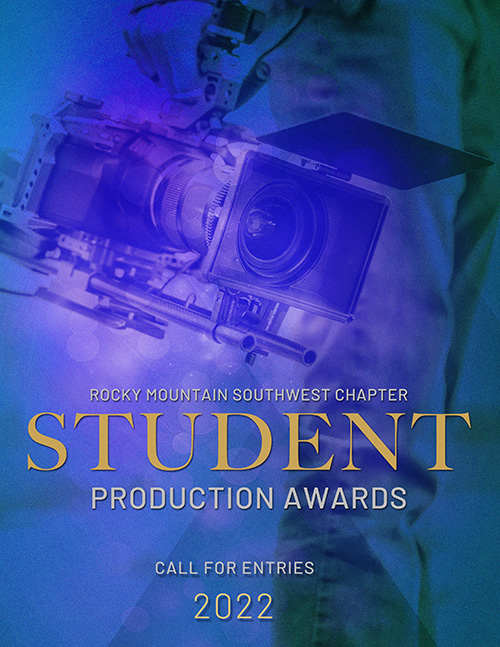ELIGIBILITY WINDOW
May 1, 2021 — April 30, 2022
ENTRY WINDOW
April 4 — May 8, 2022
THE NATIONAL ACADEMY OF TELEVISION ARTS & SCIENCES
NATAS is a professional service organization dedicated to the advancement of the arts and sciences of television and related media and the promotion of creative leadership for artistic, educational and technical achievements within the television industry, best known for the coveted Emmy® Award.
PURPOSE
To recognize outstanding student achievement in production by conferring awards of merit in the Chapter’s designated awards region. The presentation of these awards is intended to be an incentive for the continued pursuit of excellence by those studying media and journalism and to focus public attention on outstanding cultural, educational, technological, entertainment, news and informational achievements by undergraduate college and/or high school students.
ELIGIBILITY AREA
All broadcast, cable, broadband, cable / community / government access and video content providers (not close circuit or venue specific) located within the following Designated Market Areas (DMAs):
- Arizona
- New Mexico
- Utah
- El Centro, CA
Fees
HIGH SCHOOL
FREE
up to 15 entries per school
After that: $50 per entry
COLLEGE/University
$ 50
flat fee per entry
ROCKY MOUNTAIN Student Production Awards
STANDARD RULES AND REGULATIONS
- Projects conceived, produced and executed by students at a high school, university, college or technical/vocational school within the Chapter’s designated awards region are eligible for student award consideration.
- Returning students who previously worked as professionals are not eligible.
- No professional services may have been employed in the production of the entry.
- Faculty involvement can only be advisory.
- Entrants must be enrolled as a full-time student during the eligibility period.
- Students may enter work that was produced as a class assignment, extra-curricular assignment or in conjunction with their academic experience.
- Students who perform professional work may enter their work in the professional awards competition, provided they meet all eligibility requirements.
- No entry may be submitted to more than one Chapter’s awards.
- The entry does not need to have been broadcast, cablecast or webcast to be eligible.
- Entry videos must as they were originally submitted to their advisor. There may not be any edits to the originally completed video except for edits to bring the entry length within the specified category time limit. When editing for time, use only straight cuts with one second of black to denote where content has been removed.
- There is no limit to the number of entries a school may submit in each category.
- Pornographic, violent, defamatory or offensive material is not accepted. The interpretation of the Awards Committee is final and absolute.
- Ineligible entries may be disqualified during any phase of the competition.
ROCKY MOUNTAIN Student Production Awards
CATEGORIES
COLLEGE/University
HIGH SCHOOL
For over a decade the regional chapters of The National Academy of Television Arts & Sciences have hosted the Regional High School Student Production Awards. These competitive Awards include programming and craft categories. Each of the recipient schools receives a crystal pillar with the Student Production Awards logo recognizing the achievement of the student production. The students receive individual certificates from their regional chapter.
Regional recipients will automatically advance to the National Student Production Awards. Recipients of these national awards will be announced at an event later in the year.
2022 CALL FOR ENTRIES
SUBMISSIONS ARE NOW CLOSED
Categories
COLLEGE/UNIVERSITY
C-01 · Newscast
C-02 · News Report — Serious News
C-03 · News Report — Light News
C-04 · Multimedia Journalist (MMJ)
C-05 · Video Essay
C-06 · Non-Fiction — Short Form
C-07 · Non-Fiction — Long Form
C-08 · Public Affairs/Community Service
C-09 · Arts/Entertainment/Cultura Affairs
C-10 · Magazine Program
C-11 · Music Video
C-12 · Fiction — Short Form
C-13 · Fiction — Long Form
C-14 · Sports Story or Segment
C-15 · Sports Program
C-16 · Live Sporting Event/Game
C-17 · Public Service Announcement (PSA)
C-18 · Commercial
C-19 · Animation/Graphics/Special Effects
C-20 · Audio/Sound
C-21 · Director
C-22 · Editor
C-23 · Photographer
C-24 · Talent — News or Sports
C-25 · Talent Performer
C-26 · Writer
HIGH SCHOOL
H-01 · Newscast
H-023 · News Report — Serious or Light
H-03 · Multimedia Journalist (MMJ)
H-04 · Video Essay
H-05 · Non-Fiction — Short Form
H-06 · Non-Fiction — Long Form
H-07 · Public Affairs/Community Service
H-08 · Arts/Entertainment/Cultural Affairs
H-09 · Magazine Program
H-10 · Music Video
H-11 · Fiction — Short Form
H-12 · Fiction — Long Form
H-13 · Sports Story or Segment
H-14 · Sports Program
H-15 · Live Sporting Event/Game
H-16 · Public Service Announcement (PSA)
H-17 · Commercial
H-18 · Animation/Graphics/Special Effects
H-19 · Audio/Sound
H-20 · Director
H-21 · Editor
H-22 · Photographer
H-23 · Talent — News or Sports
H-24 · Talent Performer
H-25 · Writer
Award Ordering

CALL FOR ENTRIES PDF
GLOSSARY OF TERMS
- Serving as an “overseer” of the content, determining the overall tone, structure, look, sound, and mission of the content.
- Making strategic editorial decisions that have a significant impact on the resulting content.
- Identifying interview subjects and shoot locations.
- Scheduling interviews, shoots, and edits.
- Writing and/or approving scripts.
- Formulating ideas for graphics/animations and working with designers through completion.
- Working with editors to assure the content meets expectations and overseeing necessary changes.
- For studio-based programs or content, the producer would generally fulfill much of the above and/or oversee control room decisions, timing, etc.
